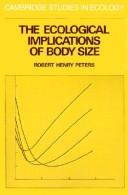| Listing 1 - 10 of 192 | << page >> |
Sort by
|
Book
ISBN: 0511608551 Year: 1983 Publisher: Cambridge : Cambridge University Press,
Abstract | Keywords | Export | Availability | Bookmark
 Loading...
Loading...Choose an application
- Reference Manager
- EndNote
- RefWorks (Direct export to RefWorks)
It is generally recognized that larger animals eat more, live longer, have larger offspring, and so on; but it is unusual to see these commonplace observations as a basis for scientific biology. A large number of empirically based relationships describe biological rates as simple functions of body size; and other such relations predict the intrinsic rate of population growth, animal speed, animal density, territory size, prey size, physiology, and morphology. Such equations almost always exist for mammals and birds, often for other vertebrates and invertebrates, sometimes for protozoa, algae, and bacteria, and occasionally even for plants. There are too many organisms to measure all aspects of the biology of every species of population, so scientists must depend on generalizations. Body size relations represent our most extensive and powerful assemblage of generalizations, but they have never been organized for use in ecology. This book represents the largest single compilation of interspecific size relations, and instructs the reader on the use of these relationships; their comparison, combination, and criticism. Both strengths and weaknesses of our current knowledge are discussed in order to indicate the many possible directions for further research. This important volume will therefore provide a point of departure toward a new applied ecology, giving quantitative solutions to real questions. It will interest advanced students of ecology and comparative physiology as well as professional biologists.
Book
ISBN: 1107298776 1107384656 1139167820 Year: 1984 Publisher: Cambridge : Cambridge University Press,
Abstract | Keywords | Export | Availability | Bookmark
 Loading...
Loading...Choose an application
- Reference Manager
- EndNote
- RefWorks (Direct export to RefWorks)
This book is about the importance of animal size. We tend to think of animal function in chemical terms and talk of water, salts, proteins, enzymes, oxygen, energy, and so on. We should not forget, however, that physical laws are equally important, for they determine rates of diffusion and heat transfer, transfer of force and momentum, the strength of structures, the dynamics of locomotion, and other aspects of the functioning of animal bodies. Physical laws provide possibilities and opportunities for an organism, yet they also impose constraints, setting limits to what is physically possible. This book aims to give an understanding of these rules because of their profound implications when we deal with animals of widely different size and scale. The reader will find that the book raises many questions. Remarkable and puzzling information makes it read a little like a detective story, but the last chapter, instead of giving the final solution, neither answers all questions nor provides one great unifying principle.

ISBN: 0521246849 Year: 1983 Publisher: Cambridge Cambridge University press
Abstract | Keywords | Export | Availability | Bookmark
 Loading...
Loading...Choose an application
- Reference Manager
- EndNote
- RefWorks (Direct export to RefWorks)
Book
Year: 2019 Publisher: Alexandria, Virginia : U.S. Department of Agriculture,
Abstract | Keywords | Export | Availability | Bookmark
 Loading...
Loading...Choose an application
- Reference Manager
- EndNote
- RefWorks (Direct export to RefWorks)
BACKGROUND: 1. Systematic reviews were conducted as part of the U.S. Department of Agriculture and Department of Health and Human Services Pregnancy and Birth to 24 Months Project.2. The goal of this systematic review was to examine the following question: What is the relationship between types and amounts of complementary foods and beverages (CFB) consumed and developmental milestones3. Complementary feeding is the process that starts when human milk or infant formula is complemented by other foods and beverages, beginning during infancy and typically continuing to 24 months of age. CFB were defined as foods and/or beverages other than human milk or infant formula (liquids, semisolids, and solids) provided to an infant or young child to provide nutrients and energy. CONCLUSION STATEMENT: 1. There was insufficient evidence to draw a conclusion about the relationships between types and amounts of CFB consumed and developmental milestones.2. Grade: Grade Not Assignable METHODS: 1. This systematic review was conducted by a team of staff from the Nutrition Evidence Systematic Review in collaboration with a Technical Expert Collaborative.2. Literature search was conducted using 4 databases (PubMed, Cochrane, Embase, and CINAHL) to identify articles that evaluated the intervention or exposure of timing of CFB introduction and the outcomes of developmental milestones. A manual search was conducted to identify articles that may not have been included in the electronic databases searched. Articles were screened by two analysts independently for inclusion based on pre-determined criteria.3. Data extraction and risk of bias assessment were conducted for each included study, and both were checked for accuracy. The body of evidence was qualitatively synthesized to inform development of a conclusion statement(s), and the strength of evidence was graded using pre-established criteria evaluating the body of evidence on risk of bias, adequacy, consistency, impact, and generalizability. SUMMARY OF THE EVIDENCE: 1. This review includes eight studies published since 1980 that examined the relationship between consuming different types and/or amounts of CFB and developmental milestones during childhood through 18 years of age, including three randomized controlled trials and five prospective cohort studies.2. The studies varied in terms of the types and/or amounts of CFB examined, which included dietary patterns consumed during the complementary feeding period, meat and/or fortified-cereal intake, and foods with differing levels of DHA or phytate3. Different types of developmental milestone outcomes were measured between 4 months and 8.5 years of age, including: ○ Communication (e.g., sentence repetition)○ Cognitive (e.g., mental development index)○ Motor (e.g., psychomotor development index)○ Neurological (e.g., cortical processing)4. Three articles from two observational studies identified positive associations between dietary patterns emphasizing vegetables and meats during the complementary feeding period, and intelligence quotient (IQ) between ages 4-8.5y. However, a conclusion could not be drawn due to low generalizability and heterogeneity in exposures, observed effects, and potential confounding5. Because there was substantial variation in how studies were designed, it is difficult to compare and contrast the reported results.6. No conclusion regarding the relationship between types and/or amounts of CFB and developmental milestones could be drawn due to an inadequate number of studies that were comparable in terms of design, the types of CFB examined, how and when developmental milestones outcomes were assessed, and reported results.
Child development. --- Infant. --- Body size.
Book
Year: 2019 Publisher: Alexandria, Virginia : U.S. Department of Agriculture,
Abstract | Keywords | Export | Availability | Bookmark
 Loading...
Loading...Choose an application
- Reference Manager
- EndNote
- RefWorks (Direct export to RefWorks)
BACKGROUND: 1. Systematic reviews were conducted as part of the U.S. Department of Agriculture and Department of Health and Human Services Pregnancy and Birth to 24 Months Project.2. The goal of this systematic review was to examine the following question: What is the relationship between types and amounts of complementary foods and beverages (CFB) consumed and developmental milestones3. Complementary feeding is the process that starts when human milk or infant formula is complemented by other foods and beverages, beginning during infancy and typically continuing to 24 months of age. CFB were defined as foods and/or beverages other than human milk or infant formula (liquids, semisolids, and solids) provided to an infant or young child to provide nutrients and energy. CONCLUSION STATEMENT: 1. There was insufficient evidence to draw a conclusion about the relationships between types and amounts of CFB consumed and developmental milestones.2. Grade: Grade Not Assignable METHODS: 1. This systematic review was conducted by a team of staff from the Nutrition Evidence Systematic Review in collaboration with a Technical Expert Collaborative.2. Literature search was conducted using 4 databases (PubMed, Cochrane, Embase, and CINAHL) to identify articles that evaluated the intervention or exposure of timing of CFB introduction and the outcomes of developmental milestones. A manual search was conducted to identify articles that may not have been included in the electronic databases searched. Articles were screened by two analysts independently for inclusion based on pre-determined criteria.3. Data extraction and risk of bias assessment were conducted for each included study, and both were checked for accuracy. The body of evidence was qualitatively synthesized to inform development of a conclusion statement(s), and the strength of evidence was graded using pre-established criteria evaluating the body of evidence on risk of bias, adequacy, consistency, impact, and generalizability. SUMMARY OF THE EVIDENCE: 1. This review includes eight studies published since 1980 that examined the relationship between consuming different types and/or amounts of CFB and developmental milestones during childhood through 18 years of age, including three randomized controlled trials and five prospective cohort studies.2. The studies varied in terms of the types and/or amounts of CFB examined, which included dietary patterns consumed during the complementary feeding period, meat and/or fortified-cereal intake, and foods with differing levels of DHA or phytate3. Different types of developmental milestone outcomes were measured between 4 months and 8.5 years of age, including: ○ Communication (e.g., sentence repetition)○ Cognitive (e.g., mental development index)○ Motor (e.g., psychomotor development index)○ Neurological (e.g., cortical processing)4. Three articles from two observational studies identified positive associations between dietary patterns emphasizing vegetables and meats during the complementary feeding period, and intelligence quotient (IQ) between ages 4-8.5y. However, a conclusion could not be drawn due to low generalizability and heterogeneity in exposures, observed effects, and potential confounding5. Because there was substantial variation in how studies were designed, it is difficult to compare and contrast the reported results.6. No conclusion regarding the relationship between types and/or amounts of CFB and developmental milestones could be drawn due to an inadequate number of studies that were comparable in terms of design, the types of CFB examined, how and when developmental milestones outcomes were assessed, and reported results.
Child development. --- Infant. --- Body size.
Book
Year: 1968 Publisher: Washington, D.C. : U.S. Department of Health, Education, and Welfare, Public Health Service,
Abstract | Keywords | Export | Availability | Bookmark
 Loading...
Loading...Choose an application
- Reference Manager
- EndNote
- RefWorks (Direct export to RefWorks)
Osteoarthritis --- Body size --- United States --- United States.

ISBN: 0195131428 9780195131420 019513141X Year: 2000 Publisher: Oxford Oxford University Press
Abstract | Keywords | Export | Availability | Bookmark
 Loading...
Loading...Choose an application
- Reference Manager
- EndNote
- RefWorks (Direct export to RefWorks)
Scaling relationships have been a persistent theme in biology at least since the time of Leonardo da Vinci and Galileo. While there have been many excellent empirical and theoretical investigations, there has been little attempt to synthesize this diverse but interrelated area of biology. In an effort to fill this void, Scaling in Biology, the first general treatment of scaling in biology in over 15 years, covers a broad spectrum of the most relevant topics in a series of chapters written by experts in the field. Some of those topics discussed include allometry and fractal structure, branching of vascular systems of mammals and plants, biomechanical and life history of plants, invertebrates and vertebrates, and species-area patterns of biological diversity.
Biomathematics. Biometry. Biostatistics --- Body size --- Morphology (Animals) --- Biomathematics. --- Body size. --- Morphology (Animals).
Book
Year: 1968 Publisher: Washington, D.C. : U.S. Department of Health, Education, and Welfare, Public Health Service,
Abstract | Keywords | Export | Availability | Bookmark
 Loading...
Loading...Choose an application
- Reference Manager
- EndNote
- RefWorks (Direct export to RefWorks)
Osteoarthritis --- Body size --- Body size. --- Rheumatoid arthritis. --- United States --- United States.

ISBN: 0387089128 Year: 1978 Volume: 24 Publisher: Berlin,New York : Springer-Verlag,
Abstract | Keywords | Export | Availability | Bookmark
 Loading...
Loading...Choose an application
- Reference Manager
- EndNote
- RefWorks (Direct export to RefWorks)
Body size --- Morphology --- Morphologie --- Measurement --- Mathematics --- Mathématiques
Book
Year: 1973 Publisher: Rockville, Md. : U.S. Department of Health, Education, and Welfare, Public Health Service, Health Services and Mental Health Administration, National Center for Health Statistics,
Abstract | Keywords | Export | Availability | Bookmark
 Loading...
Loading...Choose an application
- Reference Manager
- EndNote
- RefWorks (Direct export to RefWorks)
Youth --- Body size --- Body weight --- Anthropometry --- Body size. --- Body weight. --- Youth --- Health and hygiene --- Health and hygiene. --- United States.
| Listing 1 - 10 of 192 | << page >> |
Sort by
|

 Search
Search Feedback
Feedback About
About Help
Help News
News